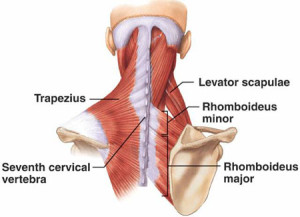Are Your Shoulders Giving You Neck Pain and Headaches?

Stiff Feet and Tight Ankles: Why Stretching Isn’t the Answer
December 3, 2015Why are you constantly injured or in pain while training for your next race?
January 5, 2016As you’d expect, I see a fair bit of patients that come in with neck pain. What you may not expect however is the small amount of treatment I give directly to the neck to correct the problem and alleviate the pain. Rather, I focus primarily on the shoulders, upper back, and core with these patients. Here’s why:
Muscles move joints, so tight muscles lead to stiff joints, and vice versa. Take the Trapezius muscle for example (shown in the picture). This large muscle is very strong and functions to control and shoulder blade when you move your arm. As shown in the picture, it connects to the spine from the upper neck, down to the mid back, and to various points around the shoulder blade. Anything that causes irritation to this muscles, like an old injury, poor posture in front of the computer, stiff joints, or weakness of other muscles of the shoulder will cause the trap to overwork and pull on the neck. This causes tightness and pain throughout the neck. It also creates excessive tension through the shoulders and upper back, leaving the shoulder blade and joints of the spine less mobile. That’s why many people that “carry stress” in their shoulders also experience frequent tension headaches.
**Bottom Line: Tight muscles and stiff joints associated with the shoulder affect the head and neck and can cause neck pain and tension headaches.
- A stiff upper thoracic spine will cause excess motion in the middle and lower neck.
Motion throughout your spine should be unrestricted, allowing you to flex forward, extend backwards, rotate and laterally bend. That being said, certain areas of the spine and naturally more mobile than others. Your neck is designed to move through all these movements much more freely that your middle and upper back, collectively known as the thoracic spine. The thoracic spine is designed to be rigged, as it contains the rib cage to protect your vital organs and acts as the foundation for many large muscles. These things make the thoracic spine more susceptible to becoming overly stiff and immobile. When you look up at the sky, you should be able to extend through the neck, but also the upper thoracic spine. If the thoracic spine doesn’t move, then ALL the motion happens in the neck. This wears on the neck over time, causing degeneration and other overuse conditions.
**Bottom Line: Joint stiffness in the upper and middle back can add stress to the joints and muscles in the neck, causing pain and degeneration.
- Irritated tissues (muscles, tendons, ligaments, and nerves) of the shoulder and upper back can refer pain up to the head and neck.
Sensory nerves that relay pain back to the brain run throughout muscles, so pain experienced in the neck may be a symptom caused from an irritated muscle of the shoulder girdle. Going back to the example of the Trap., when performing soft tissue treatments to the muscle patients will frequently tell me that they “feel it” up the side of the neck and into the base of the skull. Pressure to a tight muscle around the shoulder re-creates sensations in the neck, and therefore correcting the muscle tightness will alleviate the pain and improve motion. This is normal, and often allows the patient to really experience how the 2 areas influence each other and understand why I’m working on the area.
**Bottom Line: Symptoms felt in the neck can be generated from other areas of the body, including the shoulder and upper back.
- Most people will recruit muscles in the neck to compensate for weakness in the core.
Although I check how the core is working with all my patients, it is particularly important that I do so with patient complaining of neck pain because they often compensate for core weakness with neck engagement. I see a lot of people with weak muscles in the front of the neck and in the core. This can easily be seen watching someone do a crunch noticeable, but I see it all the time as people move around my office. To create enough strength and stability to lift off the ground, they need to activate muscles in the back of the neck instead of using the deep neck flexors and core muscles. Their chin will jut out and the neck becomes strained. This is a default mechanism your body develops to assist in stabilizing the spine. When it’s repeated over and over, whether doing crunches at the gym or getting out of bed, eventually the muscles get tighten and fatigue enough to be painful. A weak core will cause shoulder mechanics to suffer in the same way, leading to overworked muscles which can add to the neck dysfunction.
**Bottom Line: Muscles in the back of the neck are often used to help solve weaknesses in the core and shoulders and become irritated if left unattended for too long.
HOW DO WE HELP?
Simple. We pinpoint the imbalances that are causing the tight muscles and stiff joints to develop. Releasing stress and improving your ability to move through these areas reduces inflammation and irritation so you can move more freely and with less pain. If you have acute or chronic neck pain, we have answers. Call or email us for information or to set up an appointment to get started today. If you move better, you live better.
![Jaicks_logo_final[1]RGB208](https://jaicksspinesport.com/wp-content/uploads/2015/08/Jaicks_logo_final1RGB208.png)

